Abstract
The continuous proliferation of Epstein-Barr virus (EBV)-immortalized B cells is enhanced by autocrine as well as paracrine growth factors. In the present study, the possibility that EBV-immortalized B cells might produce interleukin-6 (IL-6) proteins in an autocrine manner was examined. It was found that culture supernatants from EBV-transformed B cells, but not from Burkitt's lymphoma lines, augmented the proliferation of an IL-6-dependent murine hybridoma clone, MH60.BSF2. This growth-promoting activity for hybridoma cells found in culture supernatants of EBV-transformed B cells was specifically neutralized by rabbit anti-recombinant (r) IL-6 antibody. The IL-6 activity in culture supernatants of EBV-transformed B cells, though much less than that of lipopolysaccharide (LPS)-stimulated monocytes, was increased by the addition of phorbol myristate acetate. Western blot experiments using rabbit anti-rIL-6 antiserum demonstrated that supernatants from cultured EBV-transformed B cells contained the distinct forms of IL-6, with a peak of 23,000 MW. When examined by in situ hybridization analysis, it was found that IL-6 mRNA were expressed on EBV-transformed B cells. It was noted that a fraction, but not all, of these cells expressed IL-6 mRNA strongly, implying their cell cycle-dependent expression. In addition, it was shown that rIL-6 promoted the growth of EBV-transformed B cells at low cell densities. The results suggest that IL-6 serves as an autocrine growth factor in EBV-transformed B cells.
Full text
PDF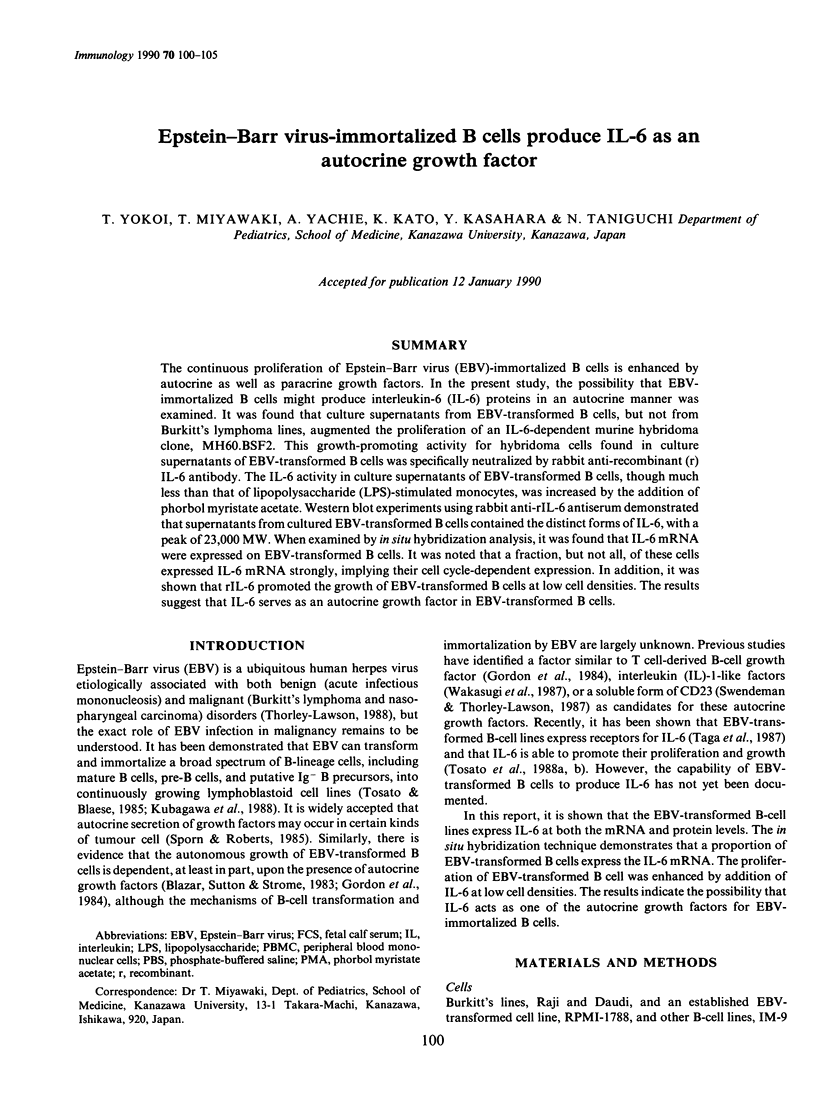
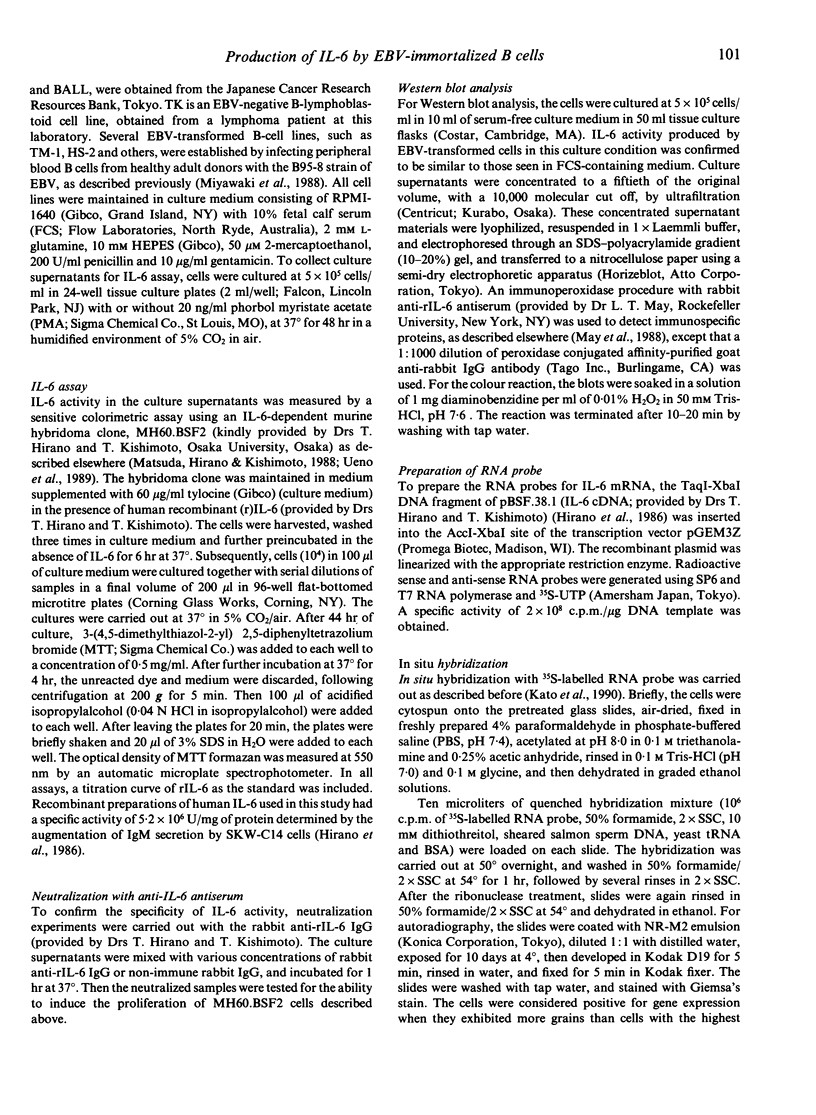
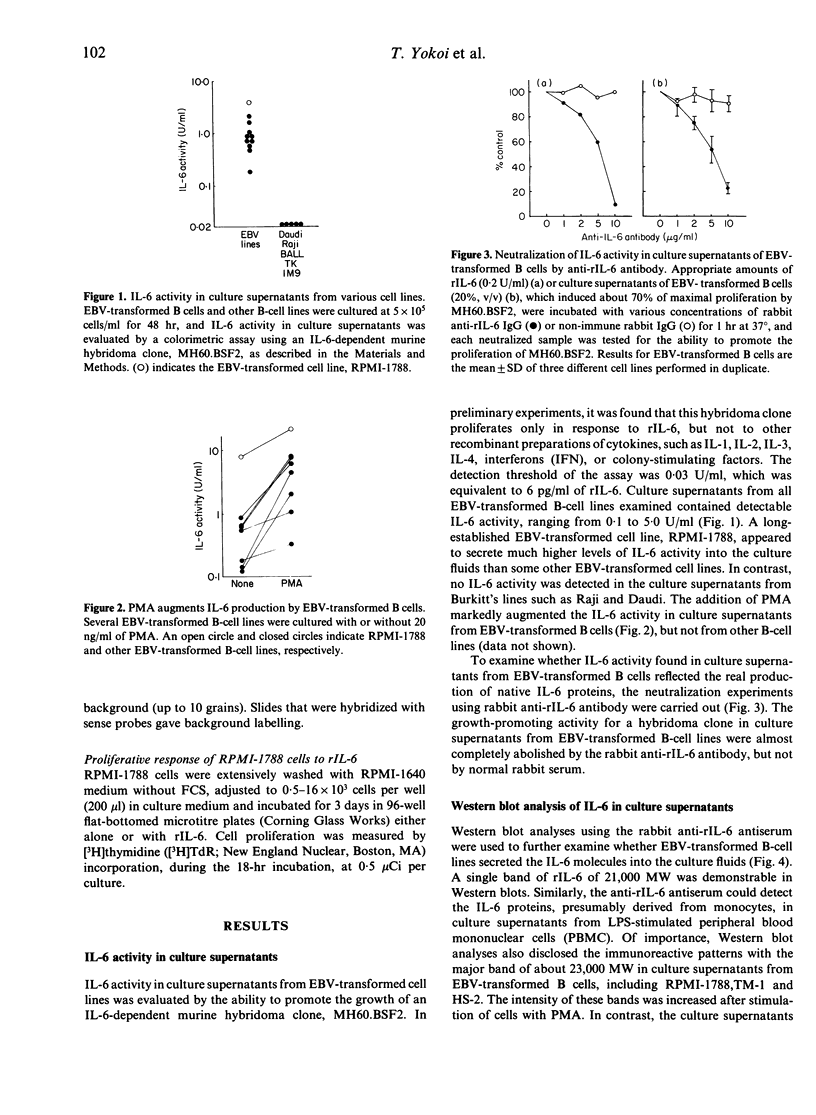
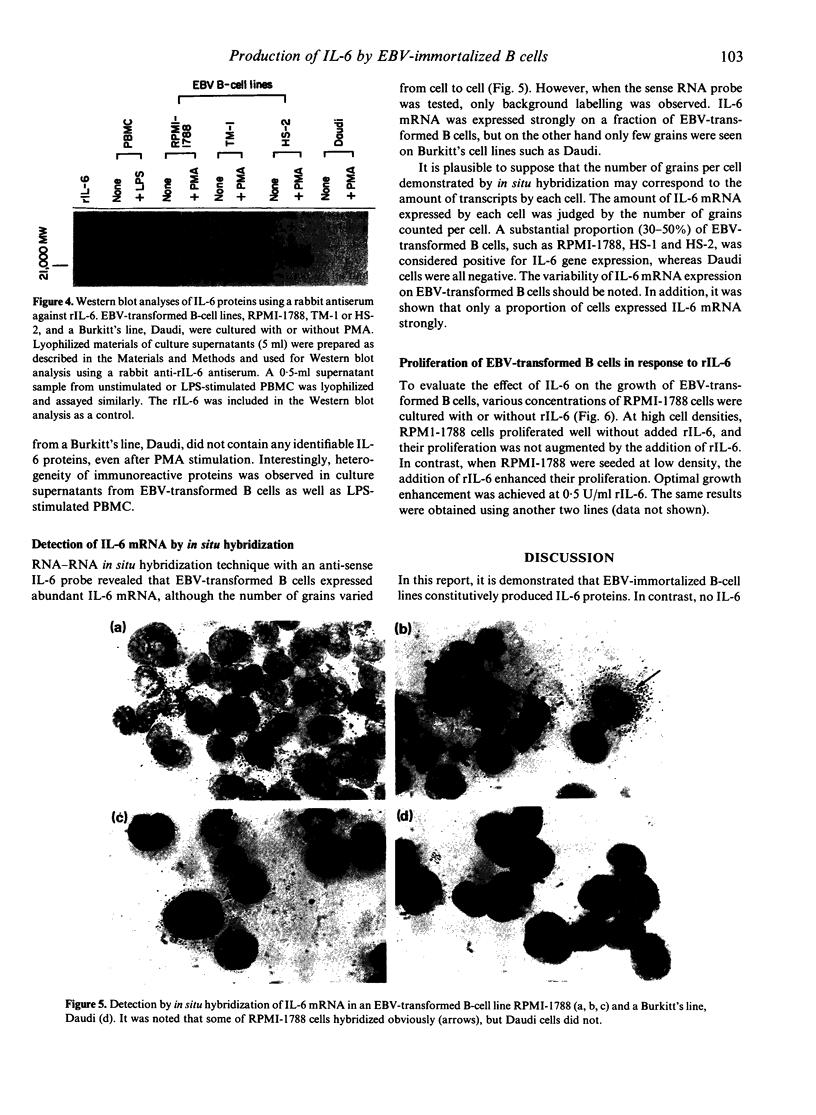
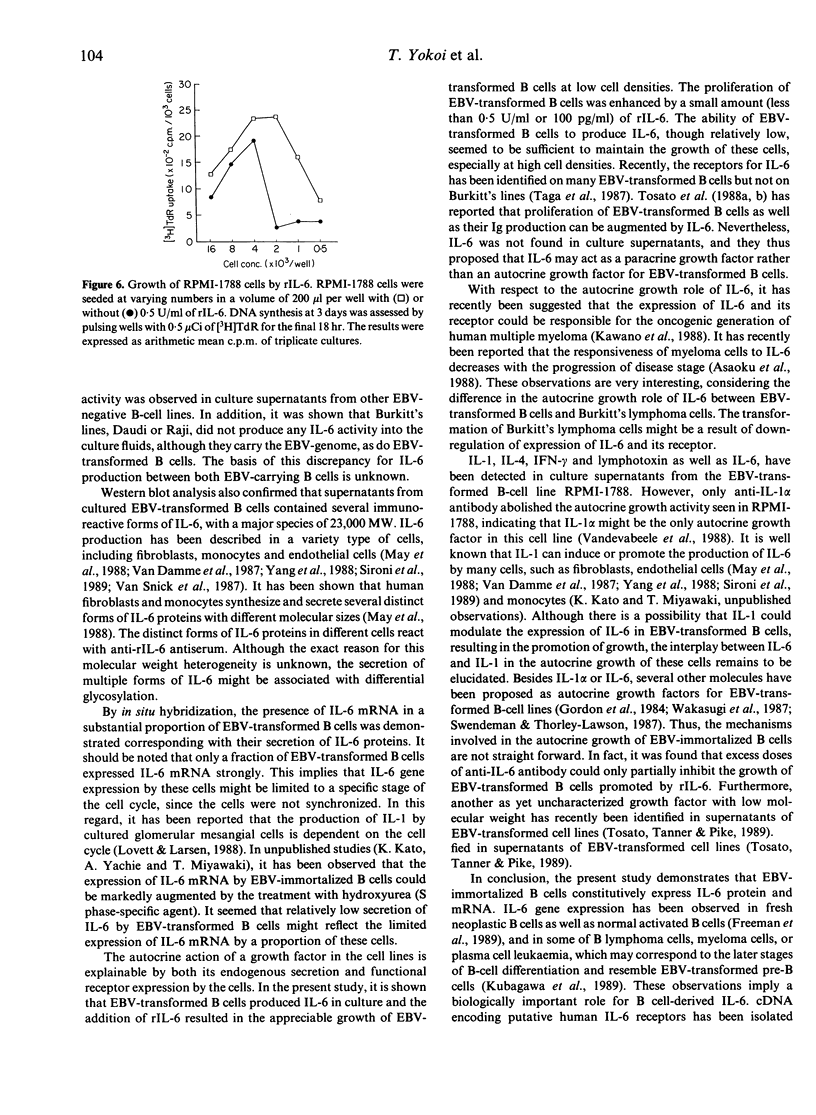
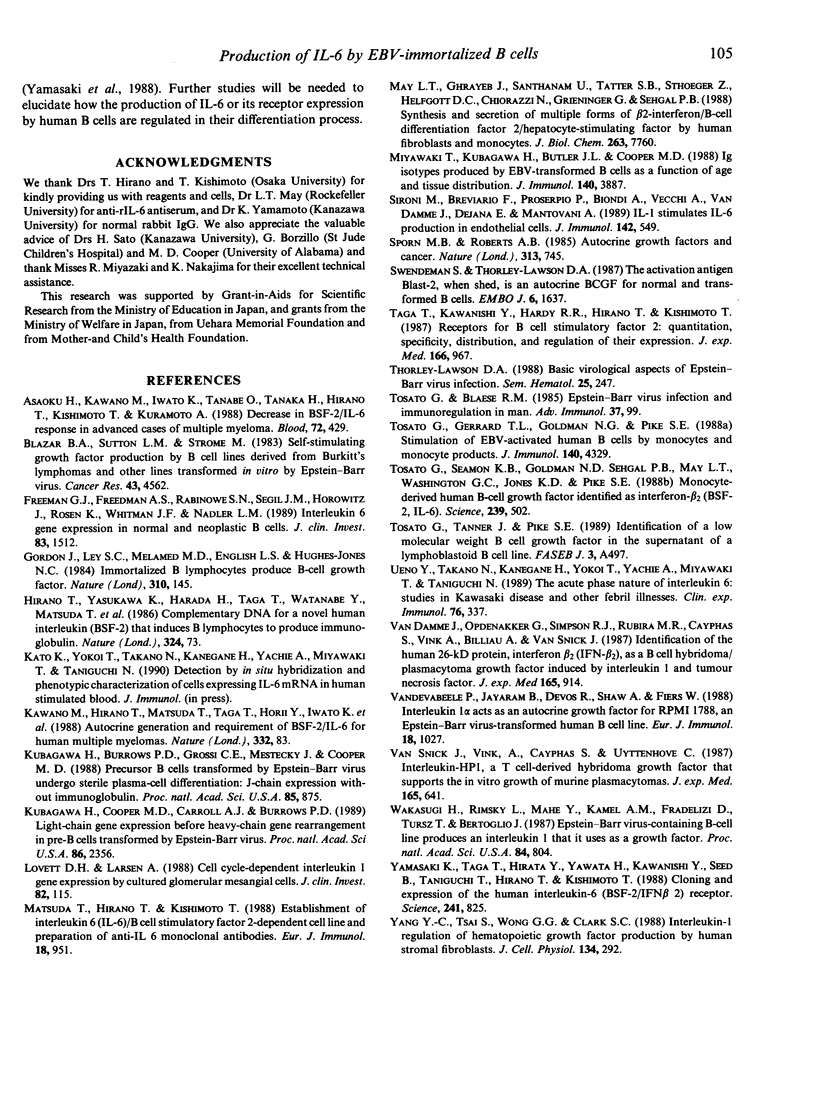
Images in this article
Selected References
These references are in PubMed. This may not be the complete list of references from this article.
- Asaoku H., Kawano M., Iwato K., Tanabe O., Tanaka H., Hirano T., Kishimoto T., Kuramoto A. Decrease in BSF-2/IL-6 response in advanced cases of multiple myeloma. Blood. 1988 Aug;72(2):429–432. [PubMed] [Google Scholar]
- Blazar B. A., Sutton L. M., Strome M. Self-stimulating growth factor production by B-cell lines derived from Burkitt's lymphomas and other lines transformed in vitro by Epstein-Barr virus. Cancer Res. 1983 Oct;43(10):4562–4568. [PubMed] [Google Scholar]
- Freeman G. J., Freedman A. S., Rabinowe S. N., Segil J. M., Horowitz J., Rosen K., Whitman J. F., Nadler L. M. Interleukin 6 gene expression in normal and neoplastic B cells. J Clin Invest. 1989 May;83(5):1512–1518. doi: 10.1172/JCI114046. [DOI] [PMC free article] [PubMed] [Google Scholar]
- Gordon J., Ley S. C., Melamed M. D., English L. S., Hughes-Jones N. C. Immortalized B lymphocytes produce B-cell growth factor. Nature. 1984 Jul 12;310(5973):145–147. doi: 10.1038/310145a0. [DOI] [PubMed] [Google Scholar]
- Kubagawa H., Burrows P. D., Grossi C. E., Mestecky J., Cooper M. D. Precursor B cells transformed by Epstein-Barr virus undergo sterile plasma-cell differentiation: J-chain expression without immunoglobulin. Proc Natl Acad Sci U S A. 1988 Feb;85(3):875–879. doi: 10.1073/pnas.85.3.875. [DOI] [PMC free article] [PubMed] [Google Scholar]
- Kubagawa H., Cooper M. D., Carroll A. J., Burrows P. D. Light-chain gene expression before heavy-chain gene rearrangement in pre-B cells transformed by Epstein-Barr virus. Proc Natl Acad Sci U S A. 1989 Apr;86(7):2356–2360. doi: 10.1073/pnas.86.7.2356. [DOI] [PMC free article] [PubMed] [Google Scholar]
- Lovett D. H., Larsen A. Cell cycle-dependent interleukin 1 gene expression by cultured glomerular mesangial cells. J Clin Invest. 1988 Jul;82(1):115–122. doi: 10.1172/JCI113558. [DOI] [PMC free article] [PubMed] [Google Scholar]
- Matsuda T., Hirano T., Kishimoto T. Establishment of an interleukin 6 (IL 6)/B cell stimulatory factor 2-dependent cell line and preparation of anti-IL 6 monoclonal antibodies. Eur J Immunol. 1988 Jun;18(6):951–956. doi: 10.1002/eji.1830180618. [DOI] [PubMed] [Google Scholar]
- May L. T., Ghrayeb J., Santhanam U., Tatter S. B., Sthoeger Z., Helfgott D. C., Chiorazzi N., Grieninger G., Sehgal P. B. Synthesis and secretion of multiple forms of beta 2-interferon/B-cell differentiation factor 2/hepatocyte-stimulating factor by human fibroblasts and monocytes. J Biol Chem. 1988 Jun 5;263(16):7760–7766. [PubMed] [Google Scholar]
- Miyawaki T., Kubagawa H., Butler J. L., Cooper M. D. Ig isotypes produced by EBV-transformed B cells as a function of age and tissue distribution. J Immunol. 1988 Jun 1;140(11):3887–3892. [PubMed] [Google Scholar]
- Sironi M., Breviario F., Proserpio P., Biondi A., Vecchi A., Van Damme J., Dejana E., Mantovani A. IL-1 stimulates IL-6 production in endothelial cells. J Immunol. 1989 Jan 15;142(2):549–553. [PubMed] [Google Scholar]
- Sporn M. B., Roberts A. B. Autocrine growth factors and cancer. 1985 Feb 28-Mar 6Nature. 313(6005):745–747. doi: 10.1038/313745a0. [DOI] [PubMed] [Google Scholar]
- Swendeman S., Thorley-Lawson D. A. The activation antigen BLAST-2, when shed, is an autocrine BCGF for normal and transformed B cells. EMBO J. 1987 Jun;6(6):1637–1642. doi: 10.1002/j.1460-2075.1987.tb02412.x. [DOI] [PMC free article] [PubMed] [Google Scholar]
- Taga T., Kawanishi Y., Hardy R. R., Hirano T., Kishimoto T. Receptors for B cell stimulatory factor 2. Quantitation, specificity, distribution, and regulation of their expression. J Exp Med. 1987 Oct 1;166(4):967–981. doi: 10.1084/jem.166.4.967. [DOI] [PMC free article] [PubMed] [Google Scholar]
- Thorley-Lawson D. A. Basic virological aspects of Epstein-Barr virus infection. Semin Hematol. 1988 Jul;25(3):247–260. [PubMed] [Google Scholar]
- Tosato G., Blaese R. M. Epstein-Barr virus infection and immunoregulation in man. Adv Immunol. 1985;37:99–149. doi: 10.1016/s0065-2776(08)60339-9. [DOI] [PubMed] [Google Scholar]
- Tosato G., Gerrard T. L., Goldman N. G., Pike S. E. Stimulation of EBV-activated human B cells by monocytes and monocyte products. Role of IFN-beta 2/B cell stimulatory factor 2/IL-6. J Immunol. 1988 Jun 15;140(12):4329–4336. [PubMed] [Google Scholar]
- Tosato G., Seamon K. B., Goldman N. D., Sehgal P. B., May L. T., Washington G. C., Jones K. D., Pike S. E. Monocyte-derived human B-cell growth factor identified as interferon-beta 2 (BSF-2, IL-6). Science. 1988 Jan 29;239(4839):502–504. doi: 10.1126/science.2829354. [DOI] [PubMed] [Google Scholar]
- Ueno Y., Takano N., Kanegane H., Yokoi T., Yachie A., Miyawaki T., Taniguchi N. The acute phase nature of interleukin 6: studies in Kawasaki disease and other febrile illnesses. Clin Exp Immunol. 1989 Jun;76(3):337–342. [PMC free article] [PubMed] [Google Scholar]
- Van Damme J., Opdenakker G., Simpson R. J., Rubira M. R., Cayphas S., Vink A., Billiau A., Van Snick J. Identification of the human 26-kD protein, interferon beta 2 (IFN-beta 2), as a B cell hybridoma/plasmacytoma growth factor induced by interleukin 1 and tumor necrosis factor. J Exp Med. 1987 Mar 1;165(3):914–919. doi: 10.1084/jem.165.3.914. [DOI] [PMC free article] [PubMed] [Google Scholar]
- Van Snick J., Vink A., Cayphas S., Uyttenhove C. Interleukin-HP1, a T cell-derived hybridoma growth factor that supports the in vitro growth of murine plasmacytomas. J Exp Med. 1987 Mar 1;165(3):641–649. doi: 10.1084/jem.165.3.641. [DOI] [PMC free article] [PubMed] [Google Scholar]
- Vandenabeele P., Jayaram B., Devos R., Shaw A., Fiers W. Interleukin 1 alpha acts as an autocrine growth factor for RPMI 1788, an Epstein-Barr virus-transformed human B cell line. Eur J Immunol. 1988 Jul;18(7):1027–1031. doi: 10.1002/eji.1830180709. [DOI] [PubMed] [Google Scholar]
- Wakasugi H., Rimsky L., Mahe Y., Kamel A. M., Fradelizi D., Tursz T., Bertoglio J. Epstein-Barr virus-containing B-cell line produces an interleukin 1 that it uses as a growth factor. Proc Natl Acad Sci U S A. 1987 Feb;84(3):804–808. doi: 10.1073/pnas.84.3.804. [DOI] [PMC free article] [PubMed] [Google Scholar]
- Yamasaki K., Taga T., Hirata Y., Yawata H., Kawanishi Y., Seed B., Taniguchi T., Hirano T., Kishimoto T. Cloning and expression of the human interleukin-6 (BSF-2/IFN beta 2) receptor. Science. 1988 Aug 12;241(4867):825–828. doi: 10.1126/science.3136546. [DOI] [PubMed] [Google Scholar]
- Yang Y. C., Tsai S., Wong G. G., Clark S. C. Interleukin-1 regulation of hematopoietic growth factor production by human stromal fibroblasts. J Cell Physiol. 1988 Feb;134(2):292–296. doi: 10.1002/jcp.1041340217. [DOI] [PubMed] [Google Scholar]




